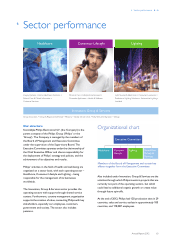Philips 2012 Annual Report Download - page 58
Download and view the complete annual report
Please find page 58 of the 2012 Philips annual report below. You can navigate through the pages in the report by either clicking on the pages listed below, or by using the keyword search tool below to find specific information within the annual report.
5 Group performance 5.3.1 - 5.3.2
58 Annual Report 2012
develop products and solutions that address
environmental and social challenges. Investments are
made to advance the LED revolution, which can
substantially reduce carbon dioxide emissions (by
switching from inefficient to energy-efficient lighting).
Furthermore, Lighting has developed solutions for water
purification, solar LEDs for rural and urban locations, and
LED solutions for agricultural applications supporting
biodiversity.
Philips Group Innovation
Philips Group Innovation invested EUR 38 million in
Green Innovations, spread over projects focused on
global challenges related to water, air, waste, and energy.
Group Innovation deployed the EcoVision portfolio
mapping tool in which innovation projects are mapped
along the environmental and social dimension to further
drive sustainable innovation. One example of a Group
Innovation project is related to LED light recipes.
Population growth and urbanization is putting a lot of
pressure on the planet’s ecological system (water,
nutrients, fertilizers, herbicides, and pesticides). There is
a variety of potential solutions and initiatives ongoing to
fundamentally change the way food is produced,
transported and monitored. We contributed through, for
example, innovations on LED light recipes in greenhouses,
city farm initiatives, light recipes to enhance plant
resistance to disease, and lighting to increase nutritious
value and shelf life in supermarkets.
5.3.2 Green Product sales
In 2012, sales from Green Products increased from EUR
8.8 billion in 2011 to EUR 11.3 billion, or 45% of sales, on
track to reach the target of 50% in 2015.
All sectors contributed to the growth in Green Product
sales. Healthcare achieved the highest Green Product
nominal sales growth (36%), followed by Lighting (26%)
and Consumer Lifestyle (20%).
The Philips EcoDesign process aims to create products
that have significantly less impact on the environment
during their whole lifecycle. Overall, the most significant
improvements have been realized in our energy efficiency
Green Focal Area, an important objective of our
EcoVision program, although there was also growing
attention for recyclability and hazardous substances in all
sectors in 2012.
Green Product sales per sector
in millions of euros
■-Healthcare_■-Consumer Lifestyle _■-Lighting
--as a % of sales
15,000
10,000
5,000
0
2008
1,527
274
2,970
4,771
22.0
2009
1,791
979
3,393
6,163
30.7
2010
2,136
1,557
4,376
8,069
36.2
2011
2,663
1,571
4,571
8,805
39.0
2012
3,610
1,888
5,752
11,250
45.4
New Green Products from each sector include the
following examples.
Healthcare
During 2012, Healthcare expanded the Green Product
portfolio with 16 new products to improve patient
outcomes, provide better value, and expand access to
care, while reducing environmental impact. All Business
Groups in the sector contributed to the increase. Imaging
Systems continued to expand the fleet of CT systems with
dose reduction and MRI systems with PowerSave, an
energy efficient feature. Philips MRI has been recognized
by COCIR as the front runner in the industry for energy
efficient MRI. In addition, Ultrasound and CT systems with
lower weight and energy usage were released. Green
Innovations from Patient Care & Clinical Informatics
include the HeartStart FR3 Defibrillator which has
eliminated a number of environmentally relevant
substances and is 25% lighter in weight than its
predecessor. At Home Healthcare Solutions, the sleep
therapy products REMStar and BIPAP A30 have
considerably lower energy use and packaging weight than
their predecessor.
Consumer Lifestyle
Consumer Lifestyle has always focused strongly on energy
management and the avoidance of substances of concern
in products, in addition to their efforts to close the
materials loop. The sector continued with the
introduction of products free of polyvinyl chloride (PVC)
and brominated flame retardants (BFR). In 2012,
Consumer Lifestyle introduced the Home Cooker, an
appliance that not only provides an extra pair of hands in
the kitchen and helps to easily create a homemade meal,
but is able to do so while consuming less energy than
conventional cooking.
























